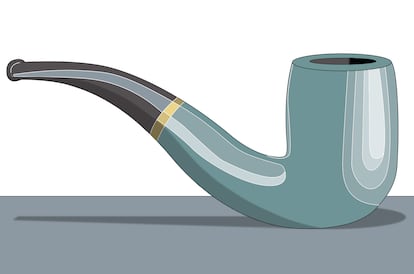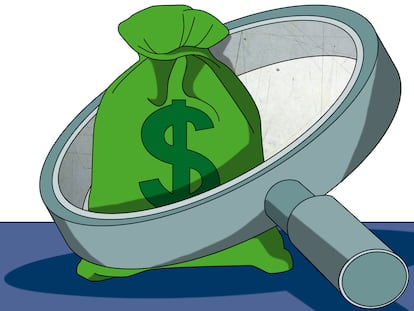This is not a business cycle
The economy’s long-term fundamentals are stronger, forcing the equilibrium interest rate higher

In May 2020, with Spanish GDP falling by 18%, we pointed to the famous work The Treachery of Images by the Belgian surrealist painter Rene Magritte, as the appropriate mental framework to understand the economic situation. What looked like a deep recession was not such, but something similar to an induced economic coma: the economy had been shut down to protect it from the virus, causing a sudden and deep collapse in economic activity, resembling a recession. But it wasn’t: while recessions are caused by imbalances that weaken the economy, the shutdown of the economy, if properly managed, should not have weakened it. As Magritte illustrates in a video, burning his paper pipe, the image does not have to be reality.
This same analogy applies to the economic recovery since the summer of 2020. It looks like a typical expansionary business cycle after a recession, but it is not. The long and persistent shock wave of the economic reopening, together with the energy crisis triggered by the Russian invasion of Ukraine, have created an unprecedented economic context with unusual fluctuations in both supply and demand. The readjustment of the composition of consumption between goods and services, the sharp swings in inventories to solve multiple bottlenecks in supply chains, the panic among businesses unable to find workers, the multiple and successive price shocks, and the difficulties of seasonal adjusting to such a unique environment, have added tremendous volatility to economic data. Applying the typical cyclical analysis to the current situation can lead to large diagnostic errors.
A key difference from the typical recovery after a recession is that the economy not only has not weakened but has emerged, to the surprise of many, more robust. This is partly due to changes that were simmering before the pandemic — the strengthening of bank balance sheets and the improvement of the design of economic policies. But mostly it is because of the management of the pandemic, which not only avoided hysteresis (for example, furlough programs) but also strengthened the short-term fundamentals of the economy, with support packages for families that raised their savings rate, liquidity assistance for businesses that prevented bankruptcies and stimulated the rapid recovery of employment or, in the case of the European Union, the suspension of fiscal rules and the adoption of the Recovery and Resilience Plan, which avoided a premature fiscal adjustment and safeguarded investment.
In addition, the management of the energy crisis, with a judicious combination of price caps, tax cuts, subsidies and aid, and energy savings — not to mention, the added luck of the mild winter weather — have limited its impact on consumption.
The result is a structurally more robust economy. If we take into account that companies, after the scary experience of not finding workers during the reopening, are hoarding labor despite doubts about growth, that financial sector profits are less vulnerable than before to interest rate rises since bank reserves are now remunerated, that central bank bond holdings have reduced the sensitivity of the private sector to interest rates, and that medium term inflation risks are now symmetrical and no longer to the downside, the result is a higher short-term equilibrium interest rate. In other words, the economy is more resilient to interest rates — with a few exceptions in pockets of the financial sector whose business model depended heavily on low and stable interest rates, as we saw last fall in the U.K. and last week in the United States.
Which explains why, despite the rapid interest rate hikes, the real economy has suffered little so far. It is true that the impact of the rate increases takes time to appear, but it is also likely that, thanks to this higher short-term equilibrium interest rate, the level of interest rates may not be too restrictive. The last decade of zero interest rates is probably not the best guide to the future: remember that eurozone interest rates reached 4.25% in 2007. Which is good news, since a higher equilibrium interest rate, even if only for a few years, creates a healthier economic context — among other things because it creates more room to lower interest rates in the face of an unexpected negative shock and reduces the expected severity of the next recession.
Furthermore, an unprecedented constellation of economic policies — what we have called the “New Economic Policy” — with a level of microeconomic interventionism much higher than anything experienced in recent decades, makes comparisons with previous cycles even more difficult. These policies, with a high component of public investment, are likely to last over time and will help keep equilibrium interest rates high.
Of course, the current episode may turn out to be the typical business cycle of an overheated economy with excessive inflation that requires a recession to stabilize: it is possible that, when all the factors unique to this recovery dissipate, inflation will be excessively high. But it is also possible that the inflation scare was a false alarm. After all, inflation expectations are anchored at the 2% target. The decline in real wages points to a labor market that, while appearing to be overheated judging by record low unemployment, is behaving very prudently from a wage growth standpoint. And the wide business margins make room for a partial recovery in real wages that is not inflationary.
In any case, central banks must be careful and fine tune any necessary further tightening. The rapid rise in interest rates has decimated the market value of banks’ holdings of government bonds and, while markets understand that those bonds are safe assets, nervousness about mark to market and capitalization levels has increased. Another feature that makes this period atypical: banks have always considered government bonds a safer investment than loans. Now it is less clear.
History will tell if Magritte was right, and this was not a typical business cycle. For now, it doesn’t seem like it.
Sign up for our weekly newsletter to get more English-language news coverage from EL PAÍS USA Edition
Tu suscripción se está usando en otro dispositivo
¿Quieres añadir otro usuario a tu suscripción?
Si continúas leyendo en este dispositivo, no se podrá leer en el otro.
FlechaTu suscripción se está usando en otro dispositivo y solo puedes acceder a EL PAÍS desde un dispositivo a la vez.
Si quieres compartir tu cuenta, cambia tu suscripción a la modalidad Premium, así podrás añadir otro usuario. Cada uno accederá con su propia cuenta de email, lo que os permitirá personalizar vuestra experiencia en EL PAÍS.
¿Tienes una suscripción de empresa? Accede aquí para contratar más cuentas.
En el caso de no saber quién está usando tu cuenta, te recomendamos cambiar tu contraseña aquí.
Si decides continuar compartiendo tu cuenta, este mensaje se mostrará en tu dispositivo y en el de la otra persona que está usando tu cuenta de forma indefinida, afectando a tu experiencia de lectura. Puedes consultar aquí los términos y condiciones de la suscripción digital.
More information
Últimas noticias
Welcome to the post-religion era: The idea of Christianity as the absolute truth has become obsolete
‘I thought you would like it’: The risky sexual practice popularized by TV shows and TikTok
The digitalization of tourism: ‘They promise experiences and gave us the worst possible one’
Mexican peso defies uncertainty with forecasts of a new period of stability in 2026
Most viewed
- Sinaloa Cartel war is taking its toll on Los Chapitos
- Reinhard Genzel, Nobel laureate in physics: ‘One-minute videos will never give you the truth’
- Oona Chaplin: ‘I told James Cameron that I was living in a treehouse and starting a permaculture project with a friend’
- Why the price of coffee has skyrocketed: from Brazilian plantations to specialty coffee houses
- Silver prices are going crazy: This is what’s fueling the rally











































